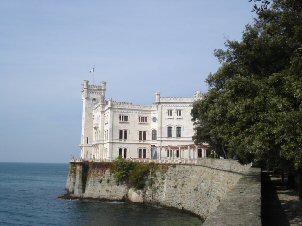

| Main |
|---|
| News |

Welcome to Trieste
| Trieste is located in the north of Italy, 100 km east from Venice, close to the border with Slovenia. Trieste faces a beautiful gulf bearing the same name, where the sea is often framed by a rocky coastline and high cliffs. The town is surrounded by the Carso plateau, which has unique flora and distinctive geological features. The area of Trieste was populated since the third millennium BC. By 177 BC, the city was under the Roman republic; it had the status of colony under Julius Caesar. During the Middle Ages, it was under Gothic, Byzantine and Frank domination. In 1382 Trieste was annexed by the Augsburg, and since then flourished under the Austro-Hungarian empire, of which it was an important centre and harbour. It joined Italy only at the end of the First World War, but the typical Middle European character of Trieste has survived to the present day, making it unique amongst Italian towns. |  |
 | The rich history of Trieste has gifted the town with numerous sites of historical interest: Piazza dell'Unità, one of the finest squares in Italy (as well the largest in front of the sea), the Roman Theatre, S. Giusto’s Cathedral (XI century), Miramare Castle (shown in the picture below) to name a few. Today Trieste is a medium size town (ca. 220,000 inhabitants), capital of the Friuli-Venezia-Giulia region. As a gateway to Eastern Europe, the town has a close relationship to Middle Europa, of which it is an important cultural centre. |
Trieste has a growing economic, commercial and political role, taking advantage of its geographical location.
Trieste and Science
In recent years Trieste has developed into a City of Science. The town hosts numerous research centres: the Abdus Salam International Centre for Theoretical Physics (ICTP), the International School for Advanced Studies (SISSA-ISAS), the International Centre for Genetic Engineering and Biotechnology (ICGEB), the AREA Science Park and many others.
The surroundings
It is possible to arrange a day-trip to Venice, to visit San Marco Square and the famous canals of the historical city. The travel takes only two hour by train (or by car on the motorway)
You may like to visit Ljubljana in Slovenia, which takes about 1 hour and ten minutes by car (95 km, including 80 km on motorway). The tour may be extended to the Julian Alps. The touristic centre of Kranjska Gora is only 80 km for from Ljubljana, and from here you can drive to the western part of the mountain chain in Italy.
Driving north-west from Trieste, you can take the motorway towards Belluno (2 and half hour drive, 195 km) and you will reach the breathtaking scenery of the Dolomites.
If you like the sea more than mountains, heading south-east you can reach the magnificent coastline of Croatia.
 Print this page
Print this page